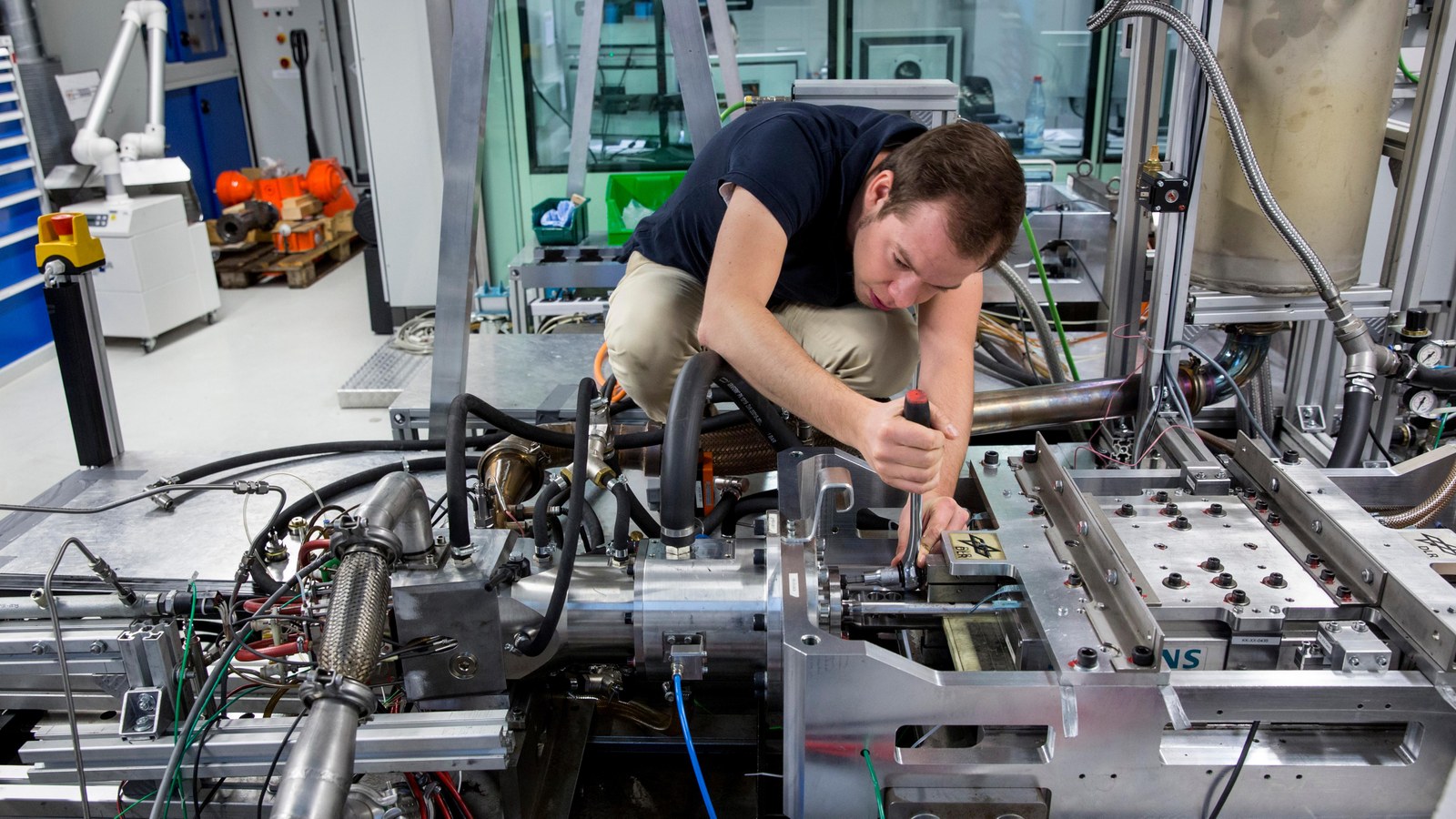Florian Kock brings new drive to electromobility


By Fabian Locher
While some may find it a tongue twister, for Florian Kock it remains a source of fascination and the object of his daily work – the Free-Piston Linear Generator (FPLG). Kock works at the German Aerospace Center (Deutsches Zentrum für Luft- und Raumfahrt; DLR) To the Institute's website in Stuttgart, where his task is to develop this new type of engine. His team is conducting research into a sustainable and innovative source of power for hybrid vehicles that might well become commonplace in as little as 10 years.
Kock was made project manager while still writing his doctoral thesis. Despite his very particular form of modesty, a touch of pride nevertheless shows through: “It seems unlikely that the majority of doctoral theses will produce an innovative engine principle unlike anything the world has seen before,” says Kock with a smile. The concept of a free-piston linear generator was first described around 1928. However, since then no one has pursued the idea of putting the theoretical principle into practice with such determination and skill as DLR for the last 10 years. Kock’s involvement began in 2010, and since then he has become responsible for four researchers and approximately the same number of student trainees. At the start of 2013, after several years of painstaking teamwork, they succeeded in demonstrating that the principle of an FPLG would work – referred to as ‘proof of concept’. “We succeeded because, luckily, we had defined the right priorities when we set about the design and construction,” says Kock, looking back.
A love of speed
The researcher likes going places fast, and not just at DLR. He spends his summers and free time out and about on his racing bike or motorcycle. A native of Hamburg, he is fascinated by speed. Working towards his doctorate at the Institute of Vehicle Concepts prompted his move to Stuttgart. Although initially homesick for North Germany, he has since settled well in the south. Kock quickly realised that the Alps are not far away – and discovered his passion for snowboarding.
Between the test rig and the computer
His frequent sporting activities are a welcome relief from working in front of a computer. A normal working day will consist of 90 percent computer work and meetings, and maybe 10 percent of practical work on the test rig. “I spent a lot more time at the test rig during the final ‘proof of concept’ phase,” he explains while opening the door leading to the approximately 30-square-metre room housing the rig in the basement of the Institute. “We built the hardware entirely by ourselves.” His gaze wanders across the metal cover of the FPLG. “It’s clear that once in a while things will go wrong. But that’s what makes our small team special. When things get hectic, we all lend a hand.”
The device itself is a monster made of steel, cables and wires, around the size of a coffin. Kock knows it like the back of his hand. “I’ve probably had every single screw in my hand at least once.” And there are a lot of screws. The test rig is an inhospitable place. Equipment buzzes, and a metallic chill hangs in the air. But Florian Kock gazes almost lovingly at the jungle of cables, hoses, control electronics, round and rectangular containers, steel drums and tools. Then his gaze hardens: “There shouldn’t really be tools lying around here,” he says firmly. There is a small workbench here, where small, customised units can be completed, pre-fitted or soldered. “But sometimes it’s misused as shelf space,” says Kock. “I’m not very keen on that.”
Travel broadens the mind
Kock discovered his love of travel back in 2013, just after the 'proof of concept' had demonstrated that the FPLG principle works. It was a good time; a milestone in FPLG project management had just recently been brought to a successful conclusion, his thesis was finished, and the institute management was enthusiastic about his decision to travel. So off he went, first to the University of Buenos Aires, where he acquired a keener understanding of different standards in practical research: “Seeing how they conduct research there was a fascinating experience. Resources that we take for granted when working at DLR simply do not exist over there. Naturally, that has to do with the circumstances in the country. But since then I have acquired an entirely different perspective of the research opportunities available at home here in Germany.”
FPLG operating principle
The amount of work on the FPLG project had not grown any smaller by the time he returned. The name says it all – the piston in the linear generator does indeed move freely, meaning it is not compelled to travel between two mechanically defined endpoints (see information box). “That was one of the biggest challenges right from the start,” explains Kock. After all, plenty can go wrong in that particular area. The piston only needs to move a fraction too far for it to impact the cylinder head at the end of the apparatus, which would cause horrendous damage. Not only would it be costly, it might also be dangerous. This is why the scientists observe the tests conducted on the FPLG from the safety of a separate control room – behind three centimetres of armoured glass. During the test cycles, at least two DLR employees keep their eyes trained keenly on the five monitors. Besides the tension of waiting to see whether the tests run as planned, the FPLG also makes a great deal of noise. “At the moment, it still sounds like you’re standing right next to a pneumatic drill. That’s one of the points we’re currently working on,” explains Kock.
Another aspect is its sheer size. As things stand, it is hard to imagine that one day, a softly humming FPLG will take its place inside an electric car, but this is precisely the goal. Installed as part of a hybrid system, FPLGs will be able generate power for the electric motor even when the batteries are discharged. Even if this sounds no more spectacular than a backup generator, it is in fact far more. Current hybrid cars can cope with shorter routes of up to 50 kilometres –for instance in city centres – using only battery power. But they should be able to handle longer distances of up to 600 kilometres once fitted with a FPLG range extender (see animation).

Der DLR-Freikolbenlineargenerator
Your consent to the storage of data ('cookies') is required for the playback of this video on Youtube.com. You can view and change your current data storage settings at any time under privacy.
DLR
Recognising and rising to challenges
The mechanical assembly was not the only daunting challenge. Florian Kock is also responsible for programming the electronics and control technology. “What we did – more or less – was develop an electronic crankshaft. We succeeded in creating a software model of what is usually a mechanical system.” It has been shown for over two years that the system works. The database software – developed in-house and used to catalogue all components – made a significant contribution to the success. “This tool is extremely important. When minor malfunctions occur, it helps us understand what it was that we installed incorrectly, when we did it, and where,” the project manager emphasises.
Kock shares a small flat in the city centre of Stuttgart with friends. “It wouldn’t be a problem to move to another city again. I haven’t put down any firm roots, and still feel relatively free,” he says with a smile. What he finds particularly enjoyable now is the task of developing an innovative drive system in a managerial position. Kock was entrusted with leading the project when his predecessor left the DLR Institute after finishing his doctoral thesis. “The initial period truly was a baptism of fire, but I am thankful for the huge opportunity.”
The Free-Piston Linear Generator (FPLG) – a highly flexible and extraordinarily efficient energy converter
The materials used to produce electric vehicle batteries are costly and have a low power density. Installing a hybrid unit consisting of an internal combustion engine and generator is a sensible way of, nevertheless, developing an electric vehicle with a low weight and acceptable production costs. This system directly drives the electric motor by converting the chemical energy stored in the fuel into electrical energy. Combined with a smaller battery, vehicles can drive shorter routes powered exclusively by the battery. The FPLG is then deployed as a power generation unit to extend the range. High efficiency, good vibration and noise properties and its compact structure are particularly beneficial aspects of an energy conversion unit such as the FPLG. The free-piston linear generator has substantial potential in these areas, and is therefore the subject of ongoing research at DLR.
How it works
A FPLG is a special kind of free-piston engine. Free-piston engines are characterised by a floating piston unit whose movement is not determined by a crankshaft. In FPLGs, the piston unit moves between two compression spaces. A fuel-air mixture is ignited in one of these spaces (the combustion subsystem). The other is used exclusively for the compression and expansion of air (the gas spring subsystem). Permanent magnets are installed between the two pistons in the piston unit and these move between the coils. Together, the permanent magnets and the coil bodies form the linear generator. The relative movement between the permanent magnets and the coils enables the energy supplied by combustion to be extracted as electric power and made available to the battery or the drive motor.
Features
• Variable compression ratio
• Variable displacement
• Linear motion
Potential
• High efficiency
• High power density
• Compact design
• Flex-fuel capability
• Minimised frictional losses
• Minimised mechanical wear
• Very good noise and vibration properties
• Few moving parts

